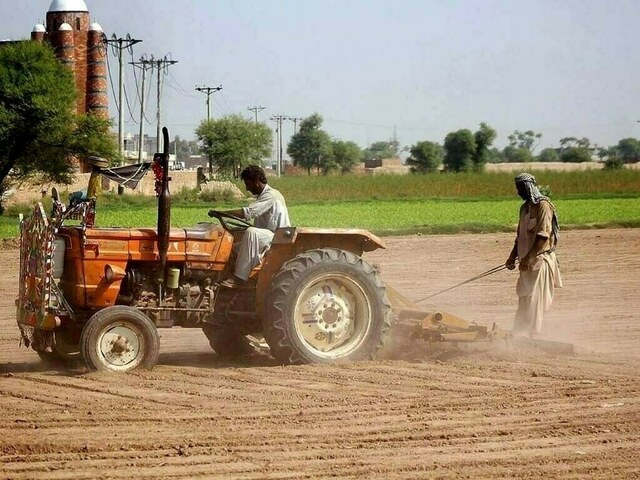ISLAMABAD: Both the governor of the State Bank of Pakistan (SBP) and the president of the National Bank of Pakistan (NBP) presented various plans and schemes aimed at promoting agriculture and aiding farmers.
A meeting of the Senate Functional Committee on Problems of Less Developed Areas was convened on Tuesday under the chairmanship of Senator Agha Shahzaib Durrani.
The session was attended by senators, Syed Kazim Ali Shah, Falak Naz, Danesh Kumar, Aimal Wali Khan, and Hamid Khan.
The governor of the SBP and the president of the NBP were also present to provide valuable insights into the current state of agricultural financing in the country. The committee met to discuss and assess the role of the banking sector in promoting and supporting the agricultural sector, which constitutes 80 percent of the country’s economy, as Pakistan is an agrarian nation.
Agricultural financing in focus
The committee received a detailed briefing on the distribution of agricultural credit through various schemes, including credit guarantee initiatives aimed at promoting rural finance for marginalised farmers, especially in the livestock and dairy sectors in less developed areas. The committee also reviewed the role of the banking sector in facilitating small and medium enterprises (SMEs) and corporate businesses in these regions.
Both the governor of the SBP and the president of the NBP presented various plans and schemes aimed at promoting agriculture and aiding farmers. However, the committee expressed dissatisfaction with the limited role played by the banking sector in advancing agricultural development, particularly in less developed areas.
Senator Durrani pointed out that only 10 percent of the country is developed, while 90 percent remains underdeveloped, stressing that no special initiatives have been undertaken to address this disparity.
Lack of awareness and public engagement
The committee chairman, Senator Durrani, highlighted the absence of concrete measures for public awareness regarding the Kissan Package, which offers financial relief to farmers. He also noted that private banks had taken up agricultural financing primarily as a business venture, with little regulatory action from the State Bank to improve the situation.
“It is regrettable that the State Bank has made no significant efforts to promote agriculture or engage with the banking sector on this issue,” said Senator Durrani. He further emphasised that international models, such as the specific funds for underdeveloped areas seen in countries like the USA, could serve as a blueprint for Pakistan.
Key agricultural credit disbursement data
The committee reviewed the latest figures related to agricultural credit disbursement for the fiscal year 2025: Agricultural Credit Performance (July-February 2025), Agricultural loans disbursed: Rs1,654.8 billion (64.3 percent of the annual target for FY25).
The outstanding agricultural loan portfolio reached Rs933.2 billion by February 2025, showing a 15 percent growth compared to the previous year.
The number of outstanding agricultural borrowers stood at 2.85 million by the end of February 2025, marking a 4.9 percent year-on-year growth. Regional distribution of loans (July-February FY25): Punjab: Rs1,269 billion (64.3 percent of total disbursements), Sindh: Rs329.9 billion (67.7 percent achievement), Khyber Pakhtunkhwa: Rs39.8 billion (49.6 percent achievement), Balochistan and other regions: Rs16.2 billion.
The committee also discussed the Kissan Package, under which Rs2.96 billion in interest was waived off for flood-affected farmers. As part of the scheme, 102,663 farmers benefited across various provinces, including Punjab, Sindh, Khyber Pakhtunkhwa, and Balochistan.
Concerns over funding distribution
The committee raised concerns regarding the disproportionate allocation of funds, with 80 percent of the agricultural credit being granted to Punjab, which is not considered a less developed region. The committee emphasised that this skewed distribution of funds neglects the needs of less developed areas, particularly in the tribal regions of Bajaur, South Waziristan, and North Waziristan.
International practices and development models
Senator Durrani stressed the need for the adoption of international best practices to address the challenges faced by less developed areas. He pointed to the success of specific funds for underdeveloped areas in the United States and suggested that Pakistan could implement similar mechanisms to promote agriculture and rural development.
“There is a pressing need for targeted funding and policies to address the unique challenges faced by underdeveloped regions. The banking sector has a crucial role to play in this effort, but it requires guidance and regulation from the State Bank,” stated Senator Durrani.
Role of the NBP
The president of the NBP, while discussing the bank’s initiatives, highlighted that NBP is the largest lender in the agriculture sector. He confirmed that the bank offers the lowest markup rates for farming sectors and has implemented a digital app, which is widely used in underserved areas to facilitate farmers.
“The NBP remains committed to providing financial support to the agricultural community. We aim to bridge the gap in underserved areas through digital solutions and low-interest loans,” said the NBP president.
However, the committee noted that while NBP’s digital initiatives are a positive step, the overall progress in terms of credit disbursement to less developed areas remains inadequate.
The Senate Functional Committee on the Problems of Less Developed Areas concluded the meeting with a call to action for the banking sector, urging both public and private banks to step up their efforts in supporting the agricultural sector, especially in less developed regions. The committee also called for greater collaboration between the State Bank, commercial banks, and government authorities to ensure the equitable distribution of agricultural credit and the implementation of policies that benefit all regions of the country.
The committee has requested a detailed report from the SBP regarding the loans provided to farmers, specifically focusing on less developed areas, and has demanded transparency in the allocation of agricultural credit.
Copyright Business Recorder, 2025


